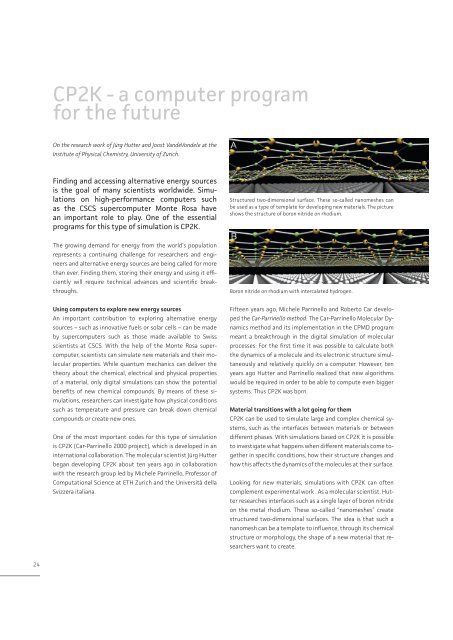Annual Report 2011 - CSCS
Annual Report 2011 - CSCS
Annual Report 2011 - CSCS
You also want an ePaper? Increase the reach of your titles
YUMPU automatically turns print PDFs into web optimized ePapers that Google loves.
24<br />
CP2K - a computer program<br />
for the future<br />
On the research work of Jürg Hutter and Joost VandeVondele at the<br />
Institute of Physical Chemistry, University of Zurich.<br />
Finding and accessing alternative energy sources<br />
is the goal of many scientists worldwide. Simulations<br />
on high-performance computers such<br />
as the <strong>CSCS</strong> supercomputer Monte Rosa have<br />
an important role to play. One of the essential<br />
programs for this type of simulation is CP2K.<br />
The growing demand for energy from the world’s population<br />
represents a continuing challenge for researchers and engineers<br />
and alternative energy sources are being called for more<br />
than ever. Finding them, storing their energy and using it efficiently<br />
will require technical advances and scientific breakthroughs.<br />
Using computers to explore new energy sources<br />
An important contribution to exploring alternative energy<br />
sources – such as innovative fuels or solar cells – can be made<br />
by supercomputers such as those made available to Swiss<br />
scientists at <strong>CSCS</strong>. With the help of the Monte Rosa supercomputer,<br />
scientists can simulate new materials and their molecular<br />
properties. While quantum mechanics can deliver the<br />
theory about the chemical, electrical and physical properties<br />
of a material, only digital simulations can show the potential<br />
benefits of new chemical compounds. By means of these simulations,<br />
researchers can investigate how physical conditions<br />
such as temperature and pressure can break down chemical<br />
compounds or create new ones.<br />
One of the most important codes for this type of simulation<br />
is CP2K (Car-Parrinello 2000 project), which is developed in an<br />
international collaboration. The molecular scientist Jürg Hutter<br />
began developing CP2K about ten years ago in collaboration<br />
with the research group led by Michele Parrinello, Professor of<br />
Computational Science at ETH Zurich and the Università della<br />
Svizzera italiana.<br />
Structured two-dimensional surface. These so-called nanomeshes can<br />
be used as a type of template for developing new materials. The picture<br />
shows the structure of boron nitride on rhodium.<br />
Boron nitride on rhodium with intercalated hydrogen.<br />
Fifteen years ago, Michele Parrinello and Roberto Car developed<br />
the Car-Parrinello method. The Car-Parrinello Molecular Dynamics<br />
method and its implementation in the CPMD program<br />
meant a breakthrough in the digital simulation of molecular<br />
processes: For the first time it was possible to calculate both<br />
the dynamics of a molecule and its electronic structure simultaneously<br />
and relatively quickly on a computer. However, ten<br />
years ago Hutter and Parrinello realized that new algorithms<br />
would be required in order to be able to compute even bigger<br />
systems. Thus CP2K was born.<br />
Material transitions with a lot going for them<br />
CP2K can be used to simulate large and complex chemical systems,<br />
such as the interfaces between materials or between<br />
different phases. With simulations based on CP2K it is possible<br />
to investigate what happens when different materials come together<br />
in specific conditions, how their structure changes and<br />
how this affects the dynamics of the molecules at their surface.<br />
Looking for new materials, simulations with CP2K can often<br />
complement experimental work . As a molecular scientist, Hutter<br />
researches interfaces such as a single layer of boron nitride<br />
on the metal rhodium. These so-called “nanomeshes” create<br />
structured two-dimensional surfaces. The idea is that such a<br />
nanomesh can be a template to influence, through its chemical<br />
structure or morphology, the shape of a new material that researchers<br />
want to create.


